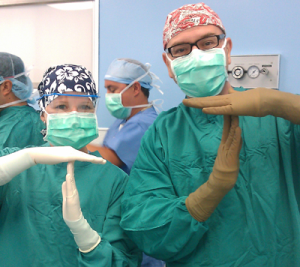June 10th is NTOD….National Time Out Day.
It may seem like we are bombarded with safe surgical checklists, time out, and correct site language all the time, but it makes sense to make Time Out a focus in our facilities one day a year for the safety of our patients.
There are still 40 wrong site surgeries occurring in health care each week, and they are the leading reported Sentinel Events.
We never want to have to tell a patient or family that we did the wrong site or wrong procedure, and knowing our processes have been reviewed, checked and tested is key.
Here are some ways in which you can make the focus effective.
When does the timeout occur?
Assign the exact moment to avoid error. A time that works is when the doctor walks in scrubbed as he reaches for his towel. Make sure that everyone knows the exact activity that prompts the timeout in your center.
What documents are part of the timeout?
A good rule of thumb is to compare the history and physical, schedule, and all consents. Have those reviews spoken. Hang a white board in the OR to list correct patient, site and procedure. Update the board prior to each procedure, before the patient enters the room.
How is the process communicated?
An effective time is when the surgeon walks in the room and reaches for the towel The circulator used the cue to state ” time out”, all verbalize their assigned communication, and the agreement follows. As an example, the circulator indicates operative and informed consents states left knee, the anesthesia provider states schedule and anesthesia consent states left knee, and the scrub tech states left knee marked. The physician states what is listed on the board. All employed and credentialed staff in the room verbalize agreement.
Include a what to do scenario if there is a conflict or discrepancy.
A keyword or words like “discrepency plan” gets spoken by ANY team member who has a concern. Verify that everyone feels empowered to do so. The rule is all stop and no further action occurs until the discrepancy is cleared. It is much better to wake a patient to clear up a concern than have a wrong site surgery.
Review your checklist. Is it an effective tool, or just another document for your staff to complete?
Work with your staff to revise if needed.
Site Marking: If digits are involved, are they marked?
I had a near miss once when a foot was marked, but toes were not. Gratefully, the time out prevented a wrong digit incision.
Are time outs performed before blocks?
Just because it’s not part of surgery, doesn’t mean that it is not just as important.
Is it the correct patient?
Have the patient check the name band prior to placing it on for correct information, and have the patient state their information, not agree to what is read. Same goes with allergies.
Have a staff meeting with a demonstration of the time out process, so everyone knows what is expected.
Or have two, one to review ideas, and, once the process is updated, one to practice.
Utilize AORN tools to promote the day.
AORN started the time out safety initiative, and offers toolkits, posters, a time out commitment form you can print and have signed, and even artwork for a cake you can download.
So mark your calendar, do a little planning, and use June 10th to make sure that everyone remembers how important the Time Out process is.




Great job. Love how you design your blog page along with the great content!